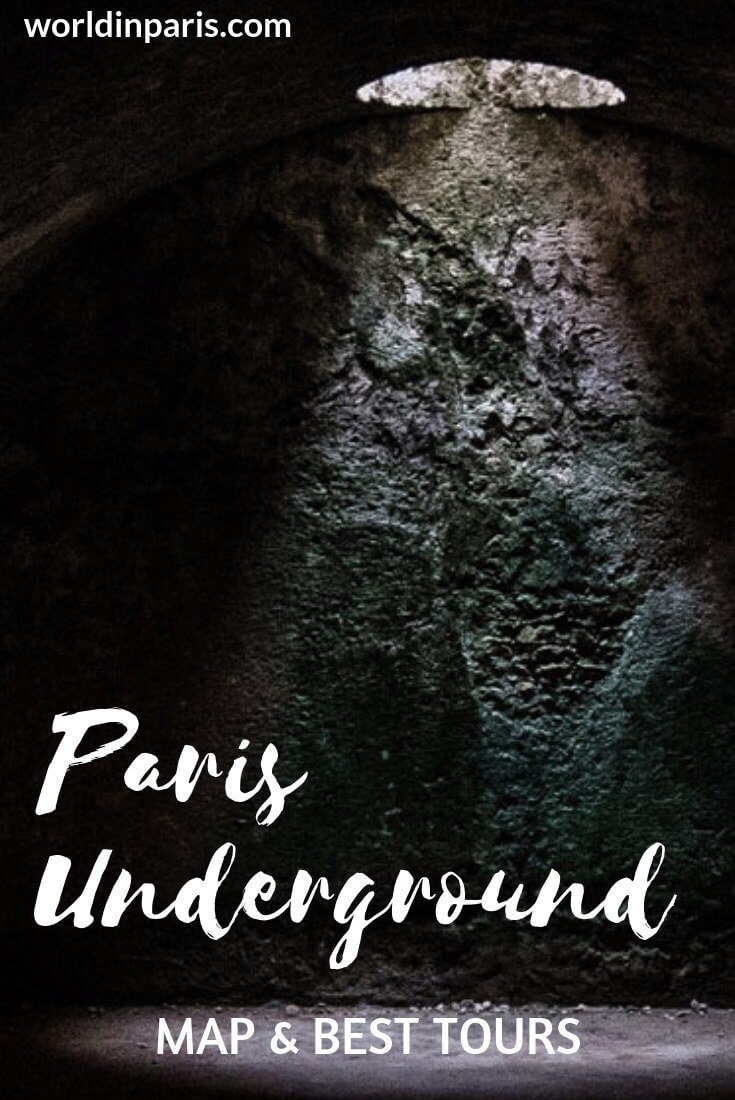Paris’ Underground City
All about underground Paris and some favorite Paris underground tours and sites.
Paris is a tale of two cities. There is the City of Light, above ground, with its beloved Eiffel Tower and the Louvre Museum. But there is also a Paris underground city, lesser-known by visitors and locals, which is more than the Paris Catacombs.
Much of Paris was built from its own Underland. Underground stone quarrying began in the thirteenth century, and Lutetian limestone was used in the construction of such iconic buildings as Notre Dame Cathedral, Saint-Eustache Church, and the Louvre Palace. The result of more than six hundred years of quarrying is a network of 130 km of underground tunnels, galleries, and chambers extending beneath several Arrondissements. Today, it is possible to visit some parts of this network through exciting underground tours. Most of these tours are also a great way to learn lesser-known parts of the history of Paris.
This quick Paris Underground guide covers the best underground sites in the city, and it is completed with some really fun underground Paris tours and visits. From the Roman Lutetia (Paris’ first settlement) to the current metro of Paris, there is something for everyone!
Are You Planning a Trip to Paris Last Minute?
If you are booking a last-minute trip to Paris, I’ve got you covered! Below are our guides, top tours, hotels, and more:
» Plan: Paris Travel Planner; Paris Arrondissements Guide; Check out the best Paris Metro tickets for tourists
» Book your flight tickets with Omio; book your train tickets with Omio
Book your transfer from the airport to the city with Welcome Pickups.
» Where to Stay: Best Districts to Stay in Paris
- Le Pavillon de la Reine (historical 5-star hotel in Le Marais)
- Hotel La Comtesse (mid-range hotel with Eiffel Tower view from all the rooms!)
- Hotel Ducs de Bourgogne (super central 4-star hotel near the Louvre)
» Top-Rated Paris Tours & Tickets:
- Louvre Museum Skip-the-Line Ticket
- Eiffel Tower Summit Access Ticket
- Seine River Night Cruise
- Château de Versailles and Gardens
- Catacombs Skip-the-line tour with VIP access to restricted areas
Want skip-the-line access at museums & attractions in Paris? Get your hands on a Paris Museum Pass!
» Don’t leave without travel insurance! SafetyWing Essential plan works well for long and short trips (from 5 days up). Can also cover electronics theft through their add-on.
Here’s what to do in Paris underground:
- Paris Catacombs
- Explore La Petite Ceinture
- Visit The Medieval Louvre Underground
- Explore Roman Lutetia in the Archaeological Crypt of Paris
- Wine Tasting in the Royal Cellars
- Tour the Sewers of Paris
- Navigate the Underground Sections of Canal Saint-Martin
- Learn About Palais Garnier’s Secret Underground Lake
- Visit Roman Lutetia’s Sewer System
- Carrières des Capucins, Locals’ Favorite Paris Underground Tour
- Metro of Paris’ Phantom Stations
- WW2 Paris Underground Tunnels
- La Maison du Fontainier and its Distribution Pools
- Regard de la Lanterne
- An Underwater Cathedral
- Wine Museum (Musée du Vin)
- Jardin des Plantes Underground
Underground Paris Map
This Paris Underground map shows the location of all the sites covered in this Paris Underground Guide. As you can see on the map, Paris’ underground city covers most of the Arrondissements of Paris!
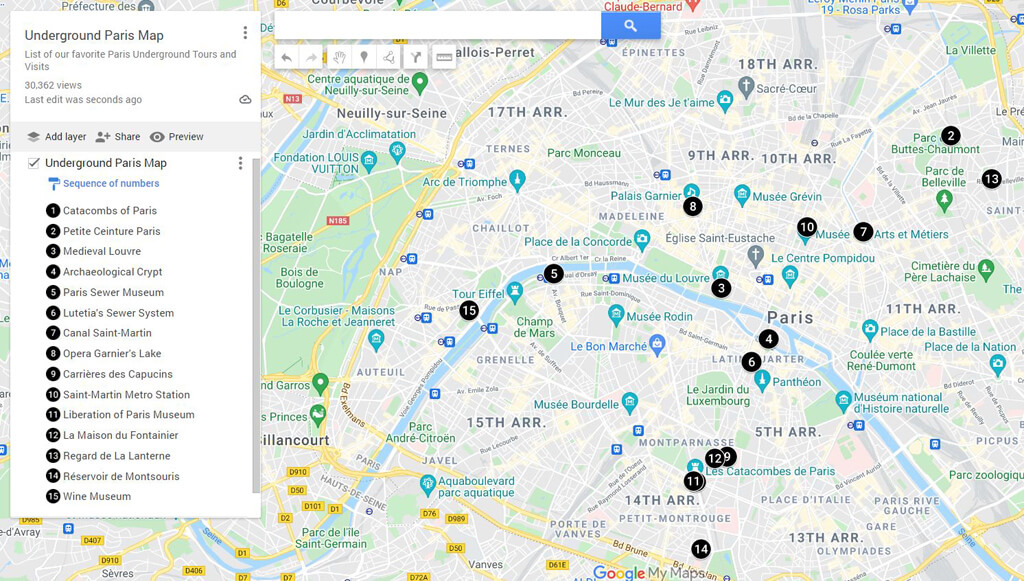
Best Paris Underground Tours and Sites
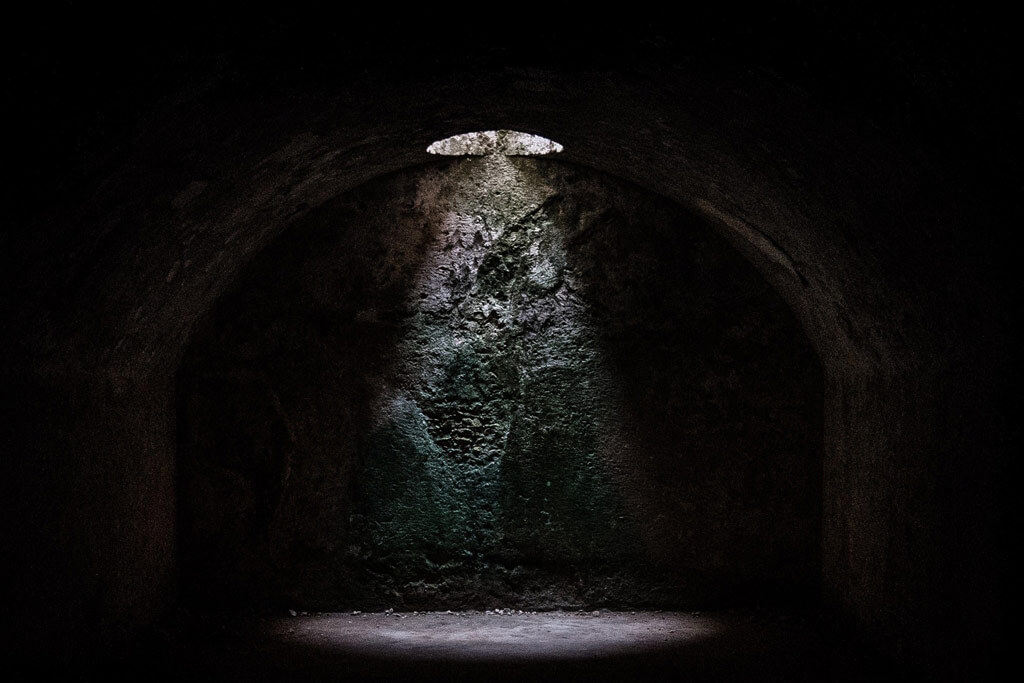
1. Paris Catacombs
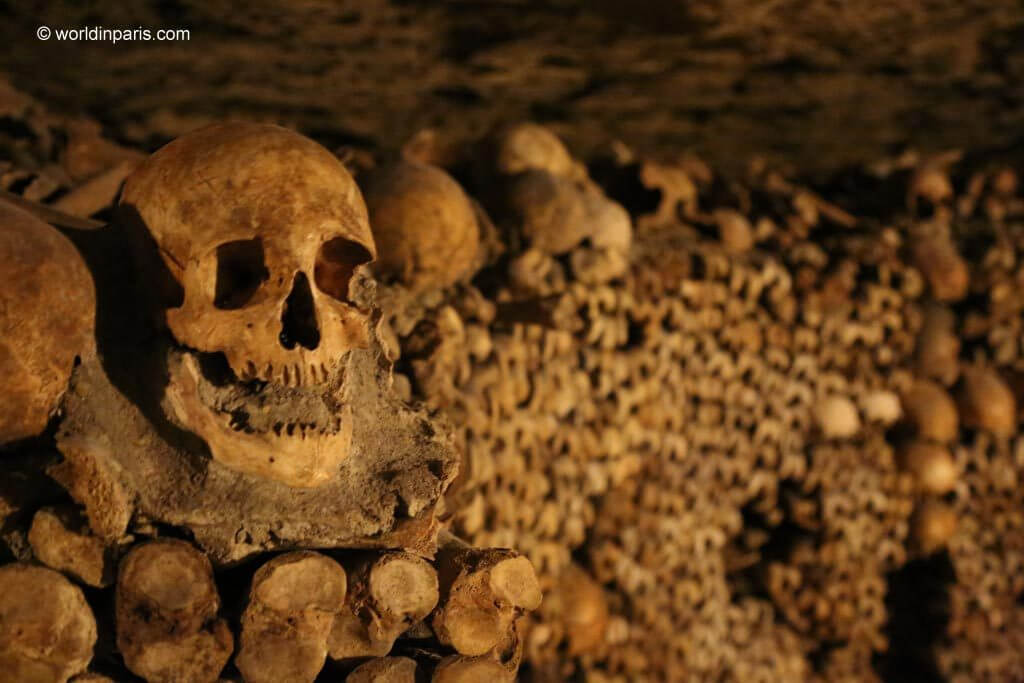
The Catacombs of Paris are 15th-century underground quarries reused years later for storing the remains of disappeared cemeteries in Paris.
A Paris Catacombs tour explores some of these Paris underground tunnels, decorated with bones and skulls from the Middle Ages. This is the most popular underground Paris tour – probably for its spooky side – and an excellent activity for those rainy days in Paris or when it’s too hot outside.
The long lines to access the Paris Catacombs with a regular ticket are famous, so a Catacombs skip-the-line ticket or guided tour is key to avoid wasting your time waiting in line.
I recommend taking this Catacombs VIP skip-the-line guided tour, which is entertaining and it gives special access to parts of the catacombs closed off to the general public (the most beautiful and exciting part of the tour, if you ask me!).
Address: 1 Av. du Colonel Henri Rol-Tanguy, Paris 14. Opening times: Wednesday to Sunday, from 9:45 a.m. to 8:30 p.m.
2. La Petite Ceinture
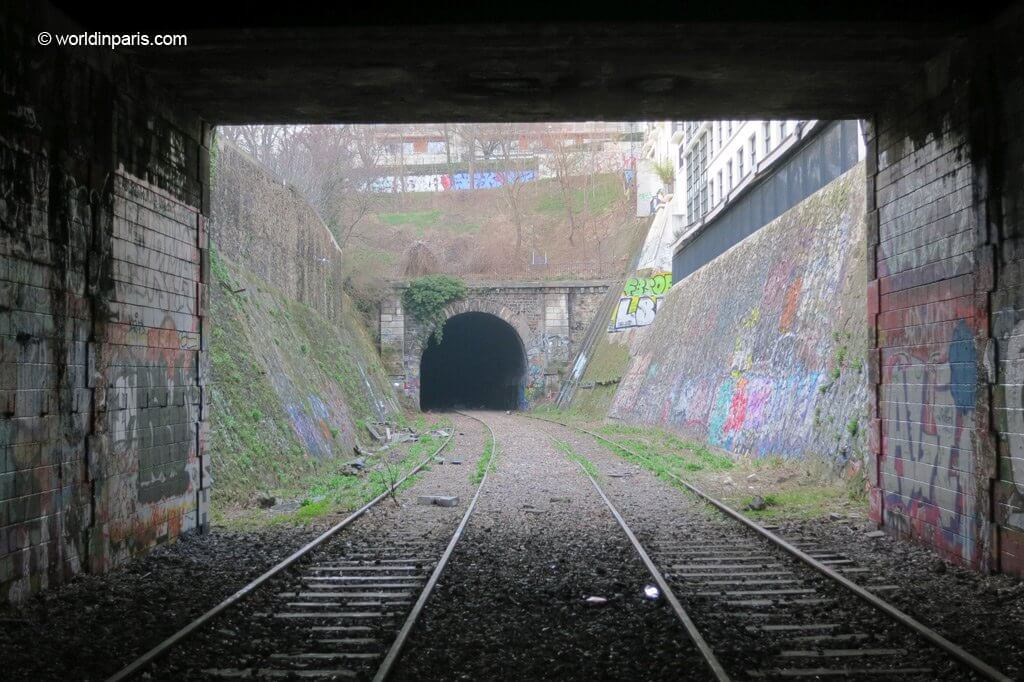
The Petite Ceinture of Paris (the Little Belt railway around Paris) was a 32 km railroad line that circumnavigated the city of Paris during the 19th century.
Originally built to transport material goods from depot yards to the core of Paris, La Petite Ceinture became, since 1862, also a service for passengers. This little train stopped operating in the ’70s when the Parisian metro became popular.
Today, some sections of La Petite Ceinture are converted into green spaces open to the public. It is possible to cross Paris underground by walking along the rails of La Petite Ceinture.
3. Visit The Medieval Louvre Underground
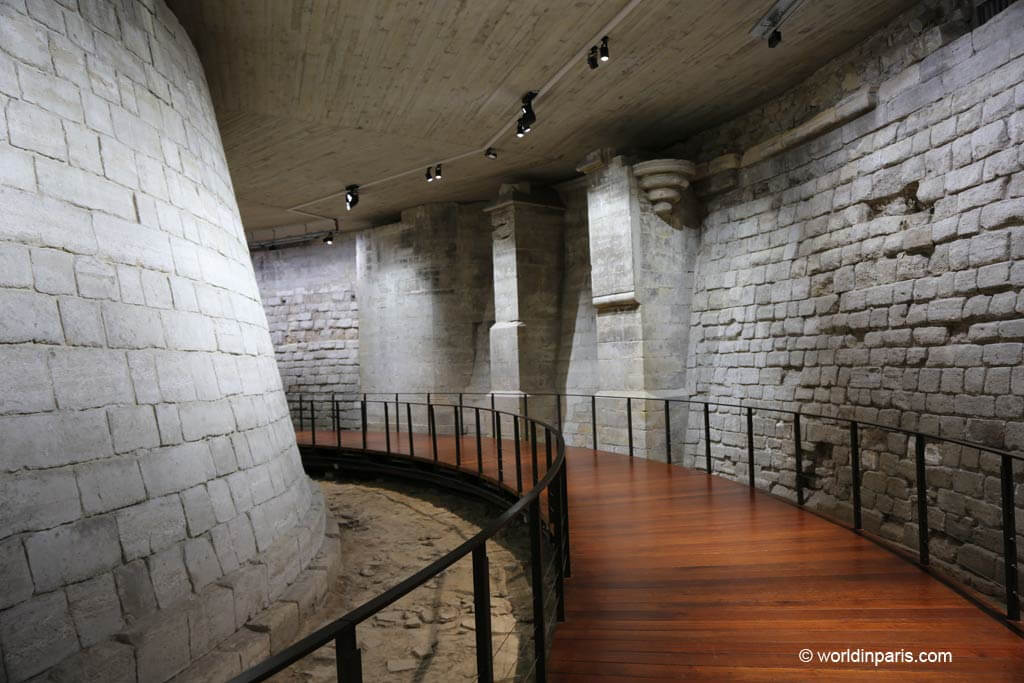
Known as the world’s most-visited museum, the Louvre Museum was built as a Royal Palace, home to the French Kings and Queens for many centuries.
The Palace of the Louvre has a long history that goes back to Medieval Paris. The construction of the Louvre started in the 12th century under the rule of King Philippe Auguste, who wanted to protect Paris better before leaving for the Crusades. At that time, the Louvre was a small medieval castle, part of the fortress protecting the city.
Over the centuries, this formerly Medieval castle was enlarged and embellished by King Philippe Auguste’s successors, and we can still visit some of those remains in the Louvre underground.
After a great mise en scène work, visitors can see some parts of the Medieval Louvre, such as the fortress’ foundations, the moat, and remains of the defensive towers – Click here to buy your Louvre skip-the-line tickets
Address: Rue de Rivoli, Paris 1. Opening times: Wednesday to Monday, from 9 a.m. to 6 p.m. On Wednesdays and Fridays, closing time is at 9 p.m.
4. Explore Roman Lutetia in the Archaeological Crypt of Paris
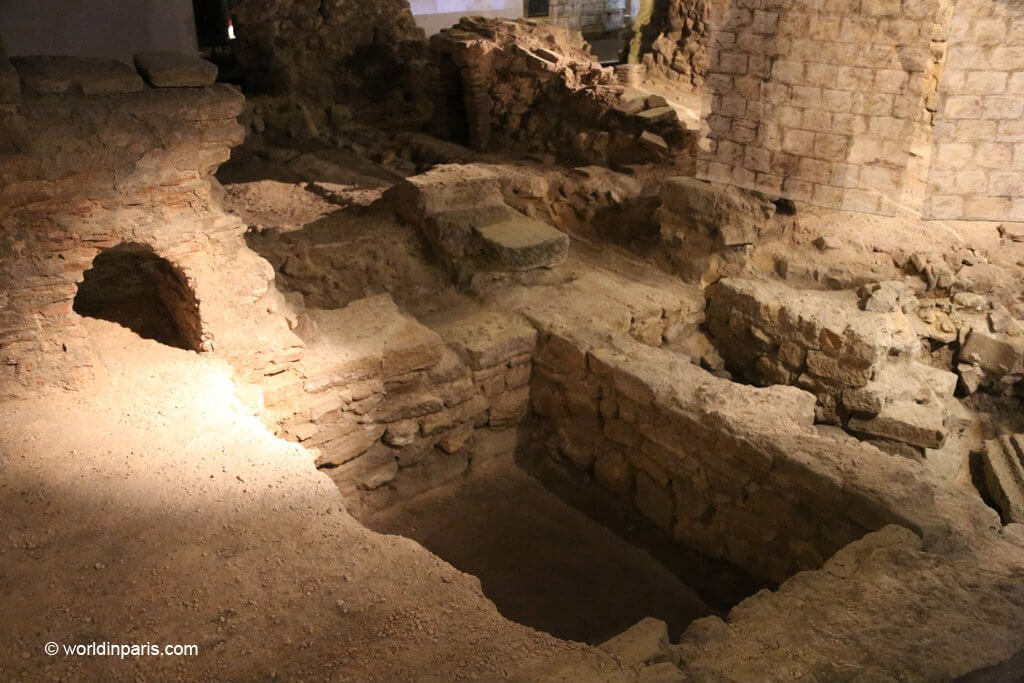
The Archaeological Crypt is a fascinating place located just in front of Notre Dame Cathedral. Despite its proximity to one of the most visited monuments in Paris, the Archaeological Crypt sees few visitors a day!
The place was planned to be an underground car park until the excavation works uncovered one of the most fascinating and well-kept parts of Roman Paris (Lutetia), which dates back to the 4th century AD.
Today, the Archaeological Crypt is an excellent place to learn about the history of Lutetia and its Gallic predecessors (the Parisii). Visitors can also explore a part of the Roman Paris underground city: streets, public baths, and even a section of the Roman harbor along the Seine River!
The picture above shows part of the public baths, a pool, and a section of the Roman walls.
Address: 7 Parvis Notre-Dame – Pl. Jean-Paul II, Paris 4. Opening times: Tuesday to Sunday, from 10 a.m. to 6 p.m.
TIP: The entrance to the Archaeological Crypt is included in the Paris Museum Pass! Check out my Paris Museum Pass review here.
5. Wine Tasting in the Royal Cellars
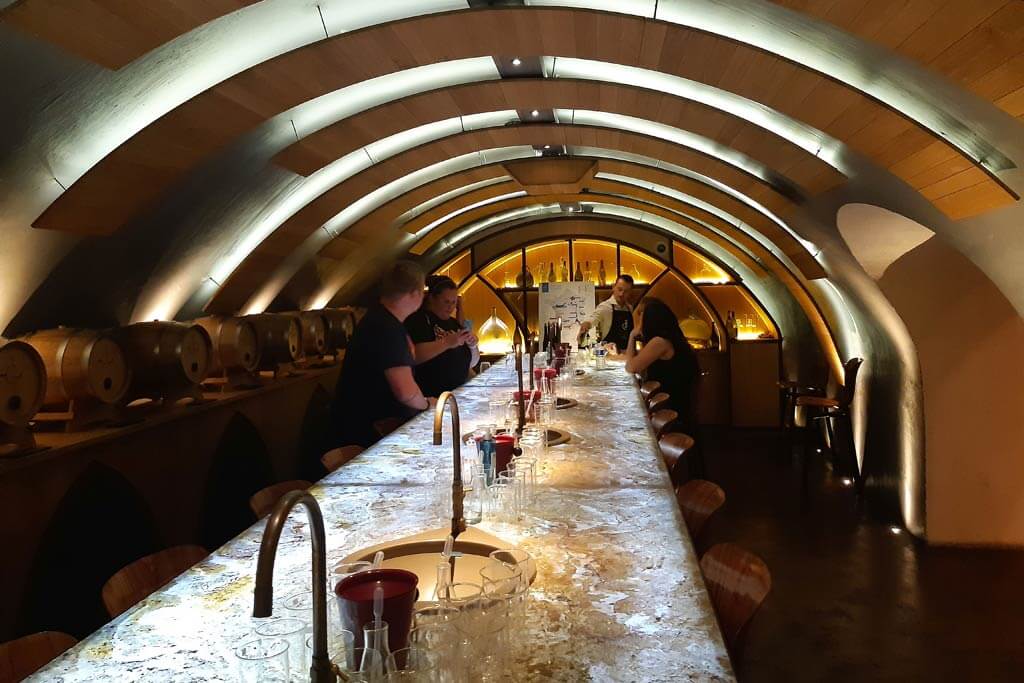
A warm day in Paris can be the perfect excuse to go beneath the ground to improve your wine-tasting skills. Not far from the world-famous museum, Les Caves du Louvre is an 18th-century wine cellar that was once used by the King of France. Now, it’s a pleasurable multisensory experience dedicated to educating visitors about the wine regions in France and the art (and science) of winemaking.
An expert sommelier will lead you through a tasting of exceptional wines (3) from different corners of the country, carefully selected to ensure a full and unique tasting experience. Distinguish a Chardonnay from a Chablis, a Beaujolais from a Burgundy, and everything in between! Click here to buy your tickets to Les Caves du Louvre
Address: 52, Rue de l’Arbre Sec, Paris 1. Opening times: Monday to Friday from 10 a.m. to 8 p.m.; Saturday and Sunday, from 11 a.m. to 8 p.m.
6. Tour the Sewers of Paris
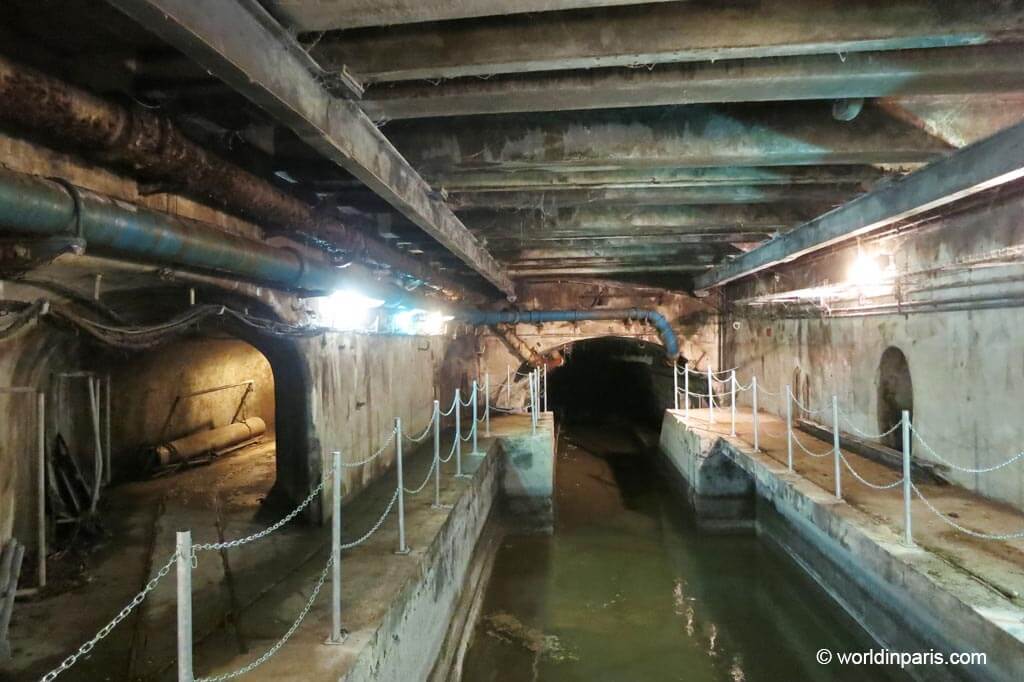
The Paris Sewer Museum is a fascinating place located in the 7th District of Paris that details the history of the sewer system and water in Paris, from the former Roman Lutetia to its modern layout (19th century).
The museum also explains the sewer workers’ role and the water treatment methods, with interesting anecdotes about water in Paris. I was happy to learn that Paris is the city with the most extensive and modern sewer system in the world!
After months of renovation, the Paris Sewer Museum recently re-opened its doors, so don’t miss this renovated museum if you are in Paris!
This Paris underground tour is self-guided. Walk through these fascinating underground tunnels, used to inspect the city’s sewer system, and learn the secrets of this underground world that manages the water supply in the city and protects it from the flooding of the River Seine.
Address: 93 Quai d’Orsay, Paris 7. Opening times: Tuesday to Sunday, from 10 a.m. to 5 p.m.

7. Navigate the Underground Sections of Canal Saint-Martin
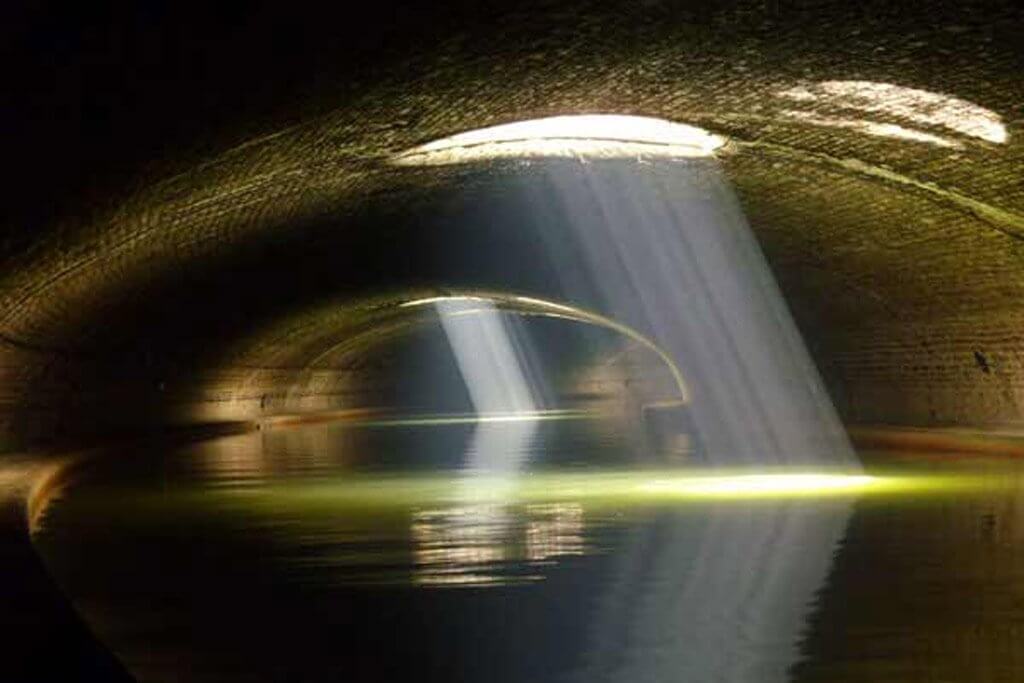
Napoleon‘s engineers designed the Canal Saint-Martin in the 19th century to bring drinking water to Paris. The Canal connects the Bassin de la Villette to the Seine River upstream with a drop of twenty-five meters.
Canal Saint-Martin has nine locks and two swing bridges, and it measures 4.5 km long, more than 2 km of which flows underground. The section underground is covered by a vault, which, years ago, was illuminated every year by the Japanese artist Keiichi Tahara at the passage of the cruise boats.
This part of the Canal is also frequently used for shooting films: movies like Ratatouille, Queen Margot, and one of the last Mission: Impossible films shot some of their scenes under Canal Saint-Martin’s vaults.
You can explore this Paris underground river and more by booking this Paris Canal Saint-Martin and Seine River tour. This beautiful boat tour from La Villette to Port de l’Arsenal is an excellent alternative to the classic Seine River cruises.
DID YOU KNOW? Paris has a second river, which has flowed underground since 1912. Read about the Bièvre River and where to find it.
8. Learn about Palais Garnier’s Secret Underground Lake
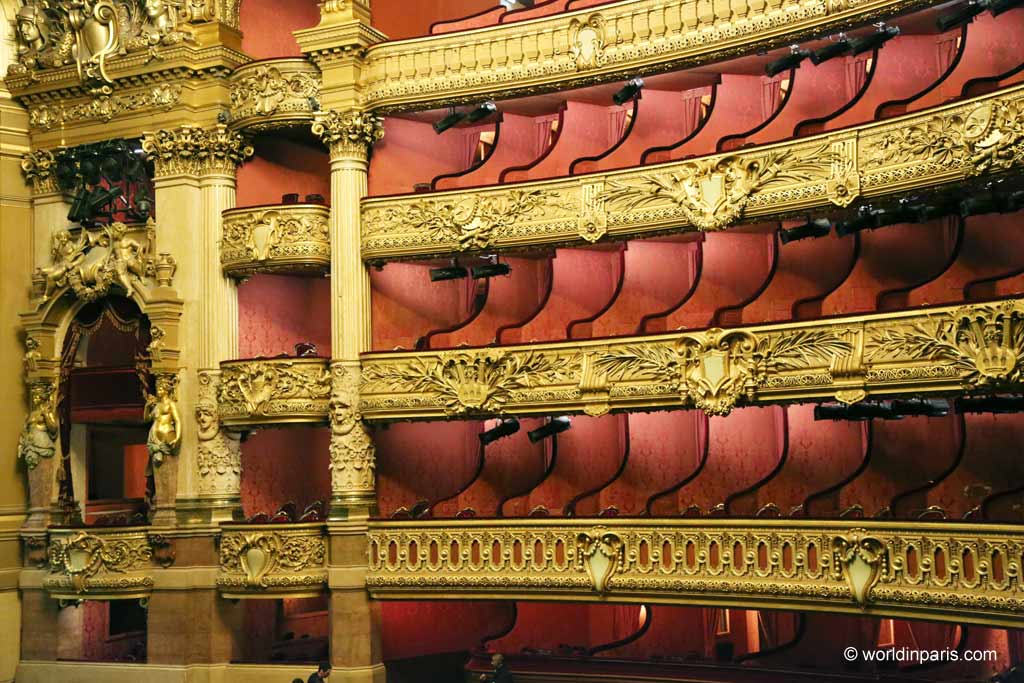
The underground lake below the grounds of the Opéra de Garnier is, in my opinion, the best secret of this Underground Paris guide! Were Gaston Leroux’s tales in his novel The Phantom of the Opera just stories?
In the book, Erik the Phantom is a deformed architect who helped build the Opera of Paris. At the same time, he secretly built a magnificent palace below the Opera’s grounds for himself, surrounded by a vast subterranean lake.
This lake really exists, and it is located exactly below the Opéra scene. This means that, somehow, the ballet dancers are dancing over the water!
When the Opéra’s foundation works started in 1852, the architects realized they were digging into a marshy area where the groundwater was very high. The Opéra’s main architect, Charles Garnier, had the brilliant idea of incorporating a cistern into his design to redistribute the water and relieve the water pressure on the basement walls. The cistern is usually full of water – like a lake –, ready to use in case of fire.
Unfortunately, only a few people have access to this underground lake, but you can explore it virtually here.
There are many fascinating mysteries and legends around the city’s beautiful Opera Theater, and you can learn about them with this Opera de Garnier self-guided tour
Address: Place de l’Opéra, Paris 9. Opening times: daily from 10 a.m. to 5 p.m.
9. Visit Roman Lutetia’s Sewer System

The Romans of Lutetia also had an efficient sewer system – different from the current sewer system – and you can see a part of it just below the Roman baths inside the Cluny Museum, in the 5th Arrondissement of Paris.
Visitors can explore these Roman Paris tunnels only during special guided visits by one of the museum’s curators. The visits are in French, but even if you don’t speak the language, the opportunity to see this Paris hidden gem is well worth it. You can check the museum’s scheduled guided tours here.
Address: 28 Rue du Sommerard, Paris 5.
10. Carrières des Capucins, Locals’ Favorite Paris Underground Tour
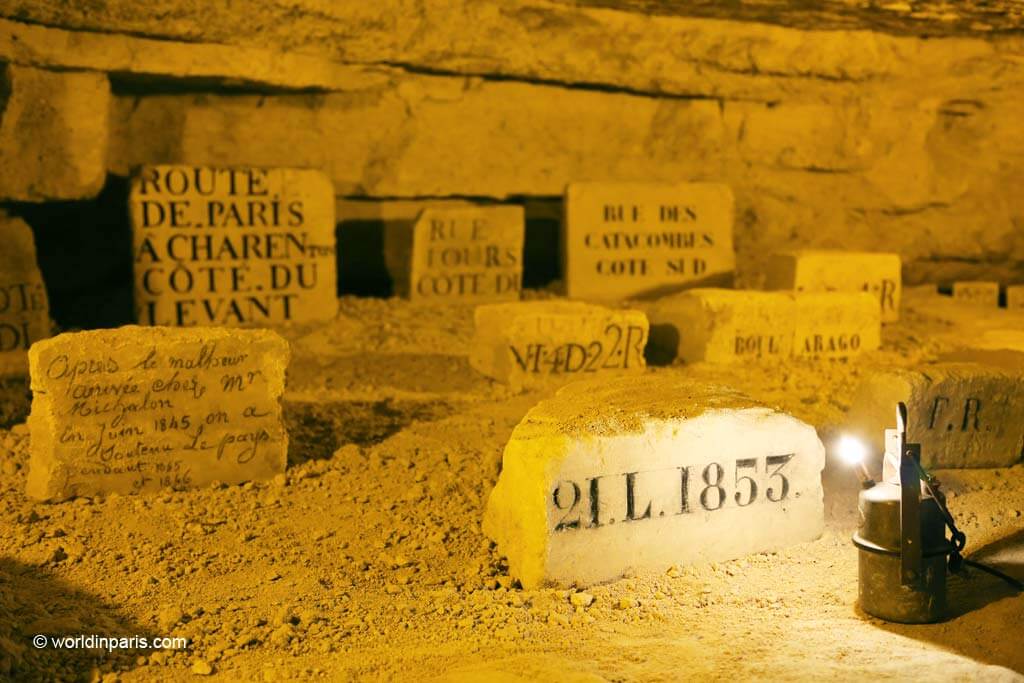
The famous Paris Catacombs only represent 0.5% of the Paris underground city. There are other places that are less easy to reach, sometimes forbidden places, which, years ago, were the object of clandestine parties and other meetings.
Talking about the legal places to visit, the Carrières des Capucins (the Quarries of the Capuchins) is a great and local alternative to the Paris Catacombs. This limestone quarry, located below the districts of Paris 14, Paris 13, and Paris 5, is maintained and enhanced by a non-profit association in the form of a museum.
This unusual and rather confidential torchlight underground tour unveils part of the city’s exceptional industrial heritage (the world of underground quarries) and some interesting curiosities. This tour (in French) is also a step back in time: indeed, under the streets of the 21st century, the Paris of the 18th century remains intact along these underground tunnels and galleries.
11. The Metro’s Phantom Stations
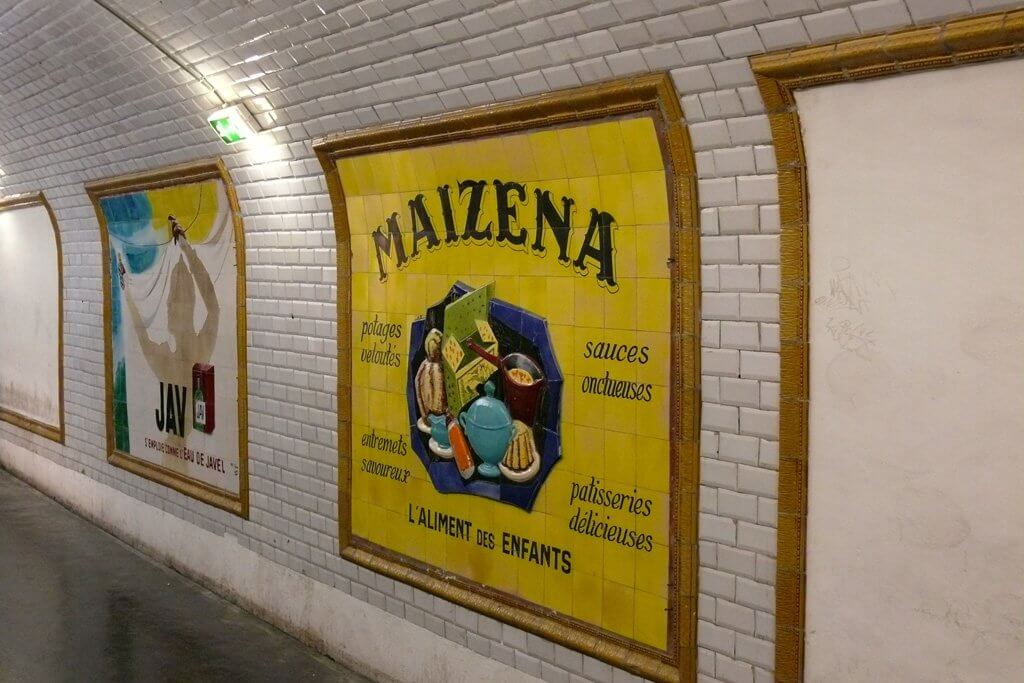
With a daily ridership of 4.16 million (2015), the Parisian Metro is the most known part of the underground Paris. The metro of Paris has 300 stations spread all over the city, and there are beautiful metro stations that you can visit with a single metro ticket.
The Parisian Metro also counts 18 phantom stations and underground tunnels abandoned for different reasons. Porte des Lilas is the most popular phantom station, often used to shoot movies. Metro scenes like the one in Amélie Poulain were shot at the Porte des Lilas metro station.
However, my favorite phantom metro station is Saint-Martin. Located in the 2nd arrondissement in Paris, this station was closed after the Second World War because it was too close to the (larger) metro station Strasbourg-Saint Denis.
Saint-Martin metro station can only be visited during special occasions. The RATP, in charge of the public transportation system in Paris, organizes these Paris underground tours.
Saint-Martin metro station is a step back in time! It still keeps the aesthetics and ceramic decoration of the 30s when it was still operational, and its advertising panels still display the products of that time. Because Saint Martin is the saint patron of ceramic workers, these workers executed stunning ceramic decorations with raised motifs for this station.
12. WW2 Paris Underground Tunnels
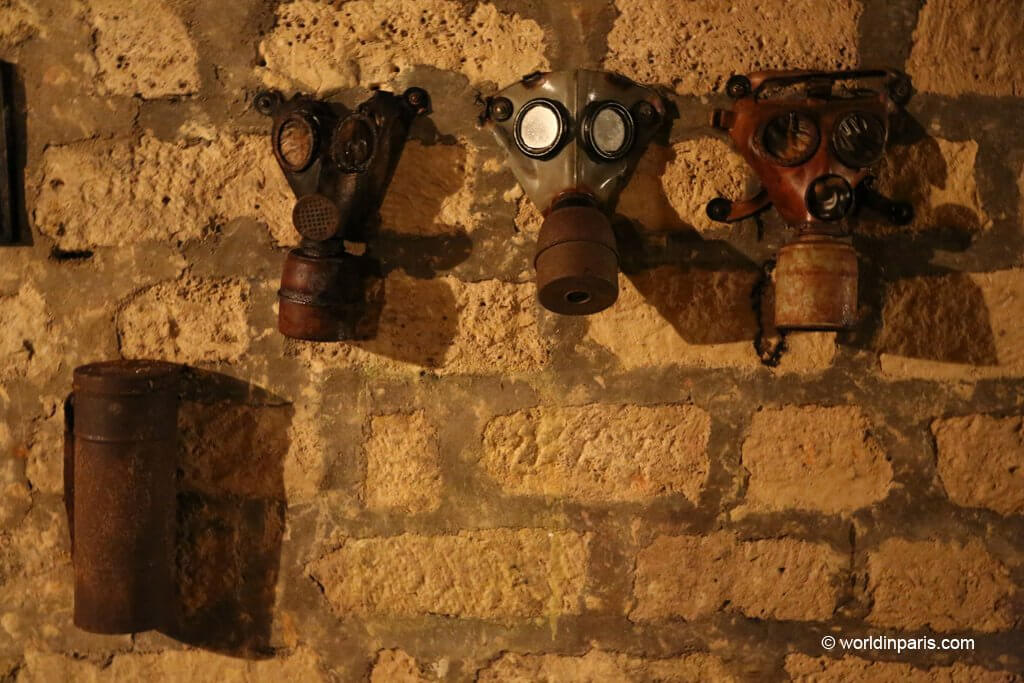
During the Second World War, the city of Paris built underground bunkers to provide “a place to retreat for citizens in case of an air attack.” Some of these bunkers are still intact, and they are an interesting place to visit, a reminder of a sad chapter of Europe’s past.
The most famous underground bunkers in Paris are located under Gare de l’Est, (open to the public on rare cultural occasions) and under Champ-de-Mars (next to the Eiffel Tower under the southern pier).
Easier to visit are the bunkers of the Carrières des Capucins and the bunker 20m below the grounds of the Musée de la Libération de Paris (pictured above). Inaugurated on the occasion of the 75th anniversary of the Liberation of Paris in 2019, this museum is one of the must-see WW2 sites in Paris.
Part of the network of free museums in Paris, the visit includes the underground command station of Colonel Rol-Tanguy, head of the Paris branch of the WW2 French Resistance.
Address: 4 Avenue du Colonel Henri Rol-Tanguy, 75014 Paris; Opening times: Tuesday to Sunday, from 10:00 a.m. to 6:00 p.m.
13. La Maison du Fontainier and its Distribution Pools
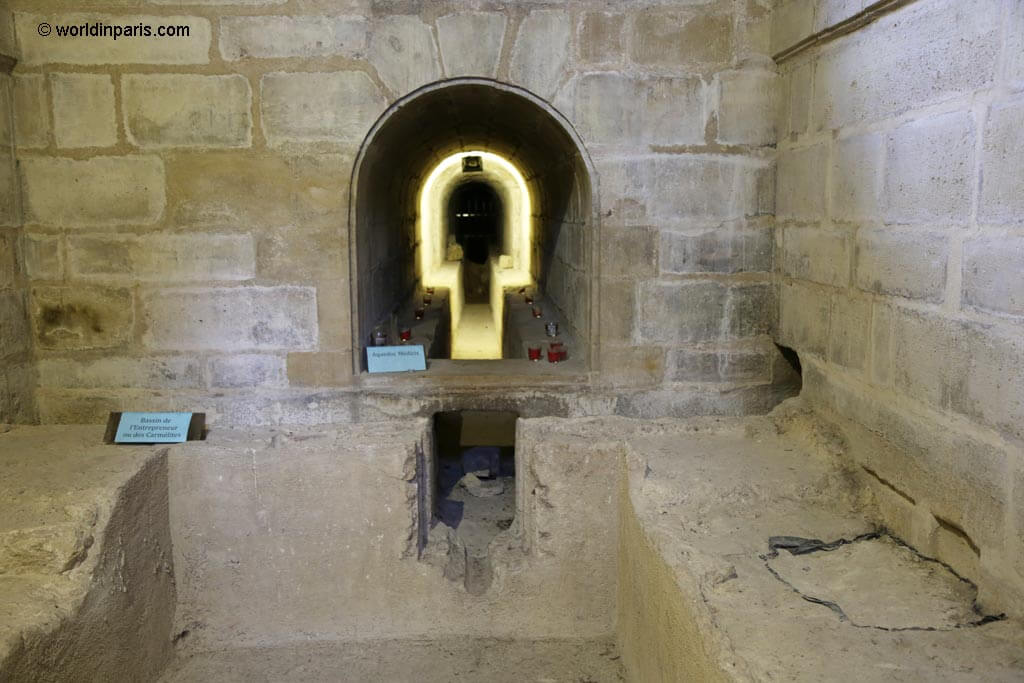
During the 17th century, King Henry IV ordered the construction of a new aqueduct to bring water to the Left Bank of Paris. This new aqueduct, known as Aqueduct Médicis, was 13 kilometers long and could be accessed through 27 different inspection chambers called regards.
Regard #27, also called Grand Regard de l’Observatoire, was the inspection chamber at the aqueduct’s end. Above it, a little house for the waters inspector (fontainier in French) was built.
The house’s grounds were divided into three vaulted chambers, each with its distribution pool. The King’s distribution pool, with the water for the use of the King, was (obviously!) the biggest. Then, there was a second distribution pool for the religious communities. Finally, the third distribution pool (the smallest) brought water for the rest of the population in Paris.
Later in 1845, the engineers Lefort and Mary built a large reservoir hall to store the overflow of water that drains at night. This tank hall is connected to the old distribution pools through a large pipe. Crossing the pipe from the old distribution pools to the tank hall is the most celebrated part of this Paris underground tour, especially for kids.
In the picture above, you can see the arrival of water from the aqueduct to the distribution pool for the religious communities. It is possible to visit La Maison du Fontainier during special cultural events such as the Heritage Days (Journées du Patrimoine) in September.
Address: 42 Av. de l’Observatoire, Paris 14.
14. Regard de La Lanterne
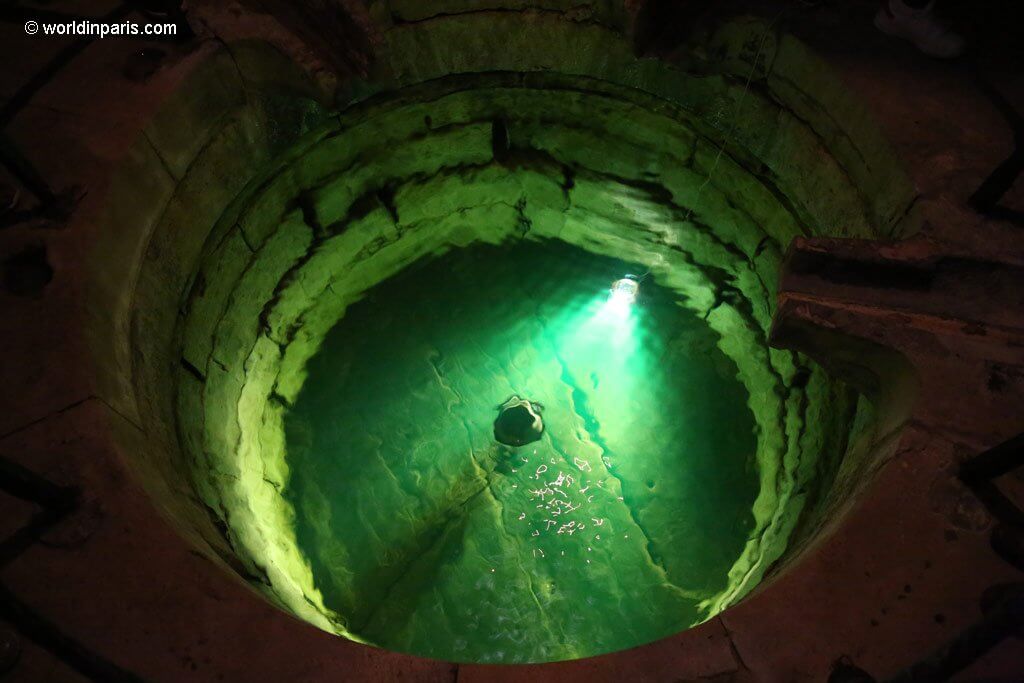
The aqueducts of Paris could be inspected thanks to different inspection chambers called regards. Today 18 ancient regards still exist in the city, but only eight are visible on the surface.
Among them, Le Regard de La Lanterne is the most beautiful. This cylindrical, stone building located in Paris 19 was built during the 16th or 17th century as the main inspection chamber for Belleville’s Aqueduct. In the past, this aqueduct brought water from the hills in Belleville to the Right Bank of Paris.
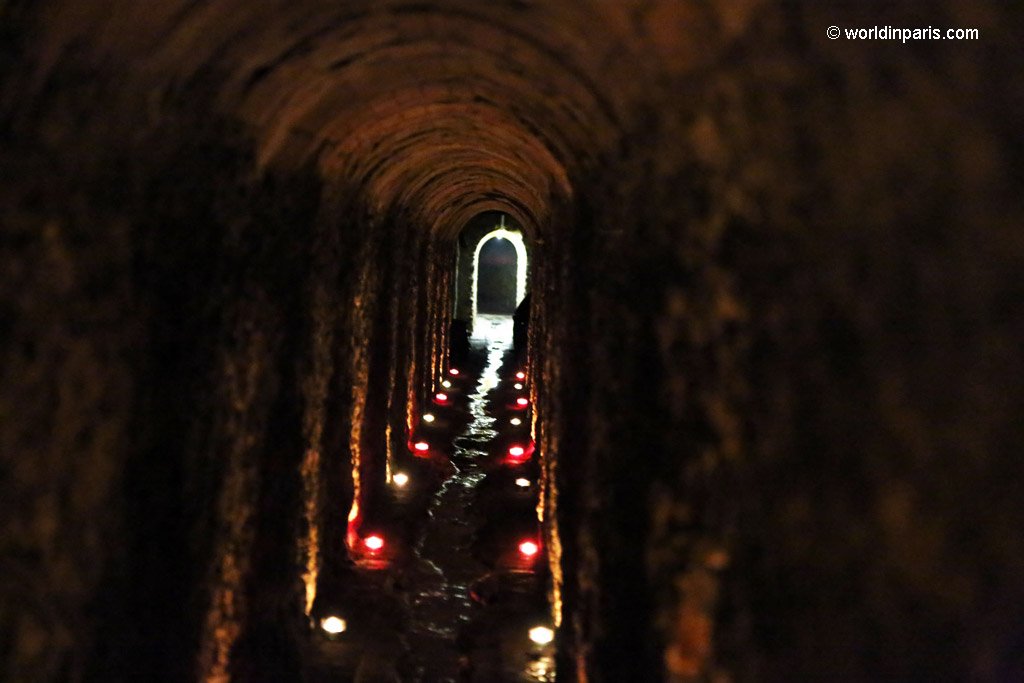
On the surface, this little regard looks like a stone mushroom. It is covered by a dome surmounted by a lantern, which allows fresh air circulation inside. Some stone steps allow visitors to descend to the bottom of the well and get a glimpse of the underground tunnels that brought the water to central Paris.
Today, this regard no longer has any technical function, but it continues to receive water from the Belleville water table.
Address: 5 Rue Augustin Thierry, Paris 19.
15. An Underwater Cathedral
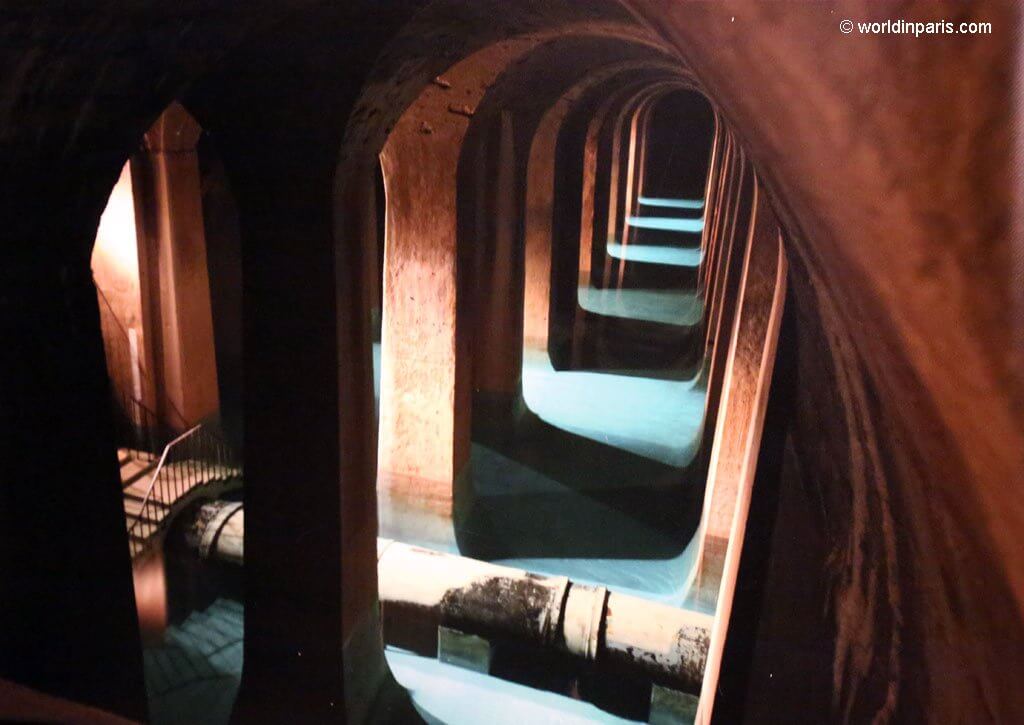
The stunning Montsouris Water Reservoir deserves to be in any encyclopedia of the underground world. It was designed between 1868 and 1873 by the engineer Eugène Belgrand, the father of the current sewer system in Paris, to feed the southern part of Paris with drinkable water.
This is definitely the most extraordinary sight on my Paris underground map, which looks like a beautiful underground cathedral with arched stone walkways in every direction and filled with turquoise water. You can see more pictures of this spectacular site here.
Unfortunately, the Montsouris Water Reservoir is listed as a “sensitive site” (this is an important water storage unit for the city), and guided visits are today forbidden by the French anti-terrorist regulations (Vigipirate).
Address: Avenue Reille, Rue de la Tombe-Issoire, and Rue Saint-Yves, Paris 14.
16. Wine Museum (Musée du Vin)
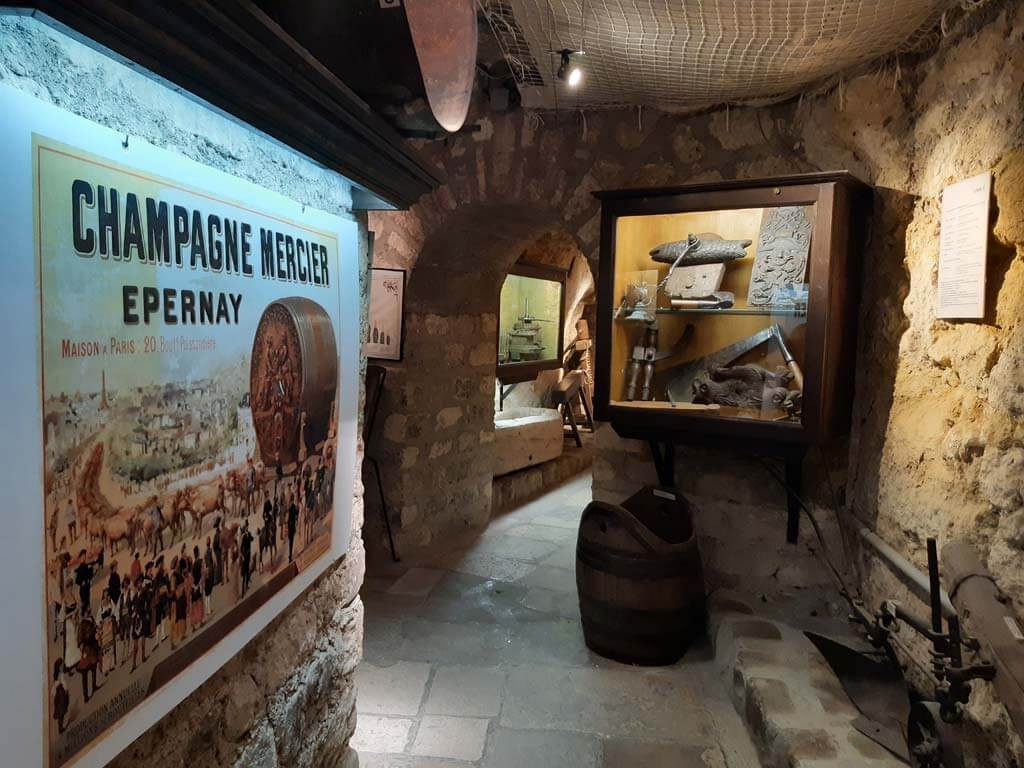
The Wine Museum of Paris is a fascinating place to explore. This underground museum is set up in former coarse limestone quarries, exploited in Medieval times to provide stone for the construction of the capital. Between the 16th and 17th centuries, the quarries became the cellars of the Minimes Convent in Paris.
Founded in the 15th century, the Couvent des Minimes de Nigeon was located between the streets of Beethoven, Chardin, and Boulevard Delessert. Its monks produced a clear wine that King Louis XIII liked to drink when he returned from his hunts in the Bois de Boulogne. With the French Revolution, the convent was abandoned and its buildings destroyed.
Rehabilitated after 1950, the Convent’s old cellars served for a time as cellars for the Eiffel Tower restaurant before becoming the Wine Museum. Since 1984, this museum has been owned by the Conseil des Echansons de France. This Brotherhood aims to defend and promote the best French wines by organizing various events in France and abroad.
The Wine Museum houses an exhibition of tools and objects that evoke the French vineyard and wines. After viewing the collection, visitors can sample a glass of wine of their choice (included in the ticket price). The site is also equipped with three vaulted cellar rooms that serve as a restaurant and spaces for wine tastings
Address: 5 Square Charles Dickens, Paris 16; Opening times: Fridays, from 10 a.m. to 2 p.m.; Saturdays, Tuesdays, Wednesdays, and Thursdays, from 10 a.m. to 6 p.m.
17. Jardin des Plantes Underground
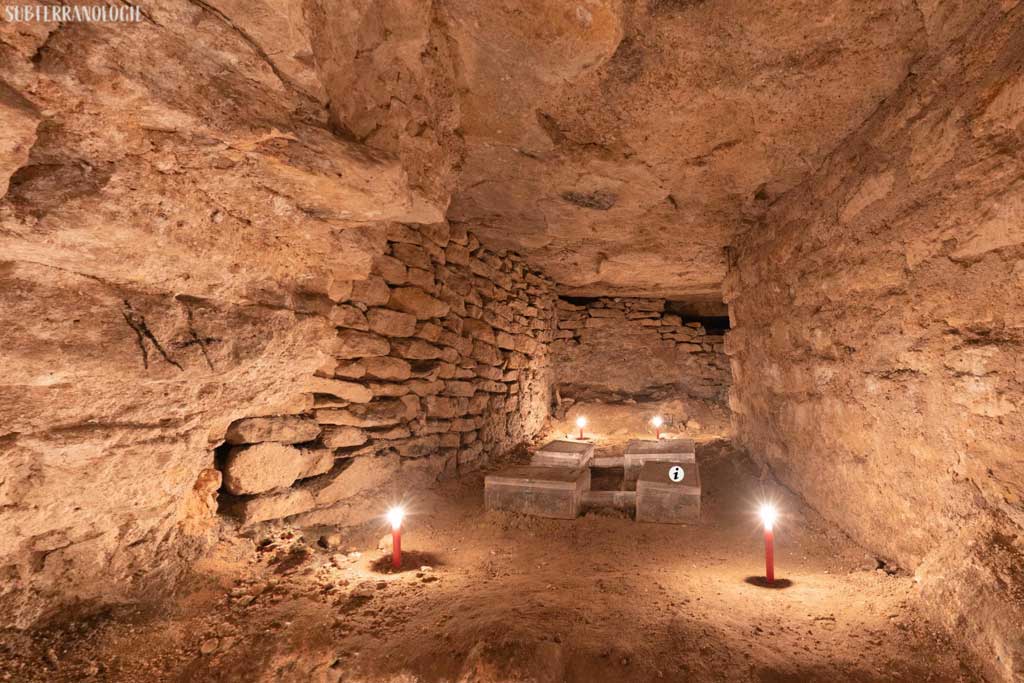
In the Latin Quarter, the Jardin des Plantes also has underground galleries and chambers. One of the accesses is at Rue Cuvier (former Rue de Seine).
These galleries, 10 meters below the garden’s grounds, were used as a zoological laboratory by Armand Viré (1869-1951), the father of bio-speleology. In the laboratory (1897), there are still some terrariums connected by tunnels that were used for experiments on cave species. There are also old flasks used to measure the acidity level of the water used.
Unfortunately, I haven’t had the chance to visit this beautiful site; the picture above is courtesy of Subterranologie.com. You can tour this amazing place virtually on his blog.
So there you have it, my personal selection of the best sites and tours of underground Paris. Which places would you like to explore right now?
Pin it now & read it later
